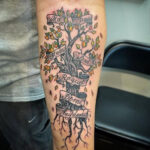Fantasy worldbuilding is about more than just magic and mythical creatures; it’s about creating societies that feel real and lived-in. One of the most powerful tools for achieving this authenticity is through exploring the concept of Family Cuisine. How families within your fictional world prepare, share, and think about food can reveal profound insights into their culture, values, and history. Just as in our own world, family cuisine acts as a cornerstone of cultural identity, shaping traditions and connecting generations.
The family unit, in its myriad forms, is the fundamental building block of any society. It’s within the family that culinary traditions are born, nurtured, and passed down. To understand a culture’s cuisine, you must first understand its families. Consider how family structures influence the culinary landscape of your world. Is the extended family the norm, with multiple generations sharing meals and kitchens, or are nuclear families more common, leading to potentially individualized family recipes? The answers to these questions will lay the groundwork for a richer and more believable food culture.
Ingredients and Flavors: Rooted in Family History
Family cuisine is intrinsically linked to the resources available and valued within a specific region. What ingredients are families likely to use? This depends on the environment, trade routes, and agricultural practices of your world. Imagine a family living in a mountainous region. Their cuisine might heavily feature hardy grains, root vegetables, and preserved meats, reflecting the challenges and bounty of their landscape. Conversely, a family in a coastal community would naturally incorporate seafood, seaweed, and salt into their daily meals.
Beyond basic ingredients, family history plays a crucial role in shaping flavors. Generational knowledge of foraging for wild herbs and spices, unique preservation techniques passed down through word-of-mouth, or even secret family recipes for specific sauces and seasonings all contribute to the distinctiveness of family cuisine. These elements add layers of depth and realism, making your fictional food culture feel less like a generic fantasy trope and more like a reflection of a genuine societal heritage.
Generational Recipes and Cooking Methods: Heirlooms of the Kitchen
Recipes are more than just instructions; they are narratives of family history. Think about how cooking methods are learned and taught in your world. Are they formally instructed, perhaps through apprenticeships or cooking schools, or are they primarily passed down through families, from parent to child, grandparent to grandchild? The latter scenario emphasizes the importance of family as the custodian of culinary knowledge.
Imagine a grandmother in your fantasy world teaching her granddaughter the precise technique for making a family’s signature bread, a skill that has been passed down for generations. This simple act of culinary transmission not only ensures the survival of a recipe but also strengthens familial bonds and reinforces cultural identity. These generational recipes become culinary heirlooms, imbued with history, memory, and love, adding emotional resonance to your world’s cuisine.
Family Meals and Rituals: The Social Fabric of Food
Family cuisine is not just about the food itself, but also about the rituals and social interactions surrounding its preparation and consumption. Consider the structure of family meals in your world. Do families eat together regularly? Is mealtime a formal affair or a casual gathering? Who is responsible for cooking and serving? These details reveal power dynamics and social norms within families and the wider culture.
Think about special occasions and celebrations. What role does food play in family gatherings, festivals, and rites of passage? Are there specific dishes associated with births, weddings, funerals, or harvests? These food-related rituals are powerful expressions of cultural values and family identity. For example, a harvest festival might feature communal baking of a special family bread, symbolizing unity and gratitude. Or a wedding feast could showcase dishes that represent the merging of two family culinary traditions.
Beyond the Conventional: Unconventional Family Cuisine
While traditional family structures often dictate culinary norms, don’t forget to explore unconventional family units and their unique cuisines. “Found families,” common in fantasy narratives, can create fascinating culinary fusions. Imagine a group of adventurers from diverse backgrounds forming a close-knit family. Their shared meals might blend culinary traditions from different regions, creating a unique and evolving family cuisine that reflects their journey and shared experiences.
Similarly, consider families that deviate from societal norms in your world. Perhaps a family living on the fringes of society develops unique foraging practices and cooking methods out of necessity or cultural difference. Exploring these unconventional family cuisines adds richness and diversity to your world, challenging traditional notions and highlighting the adaptability of culinary traditions.
Conclusion: Weaving Family Cuisine into Your Worldbuilding Tapestry
Family cuisine is a vital thread in the tapestry of any believable fantasy world. By delving into the details of how families in your creation interact with food – from ingredient sourcing and recipe传承 to mealtime rituals and unconventional culinary expressions – you can craft cultures that feel authentic, nuanced, and deeply human. So, as you build your worlds, remember to consider the heart of the home: the family kitchen and the unique cuisine it creates. This focus on family cuisine will elevate your worldbuilding, making it more immersive and resonant for your audience.

